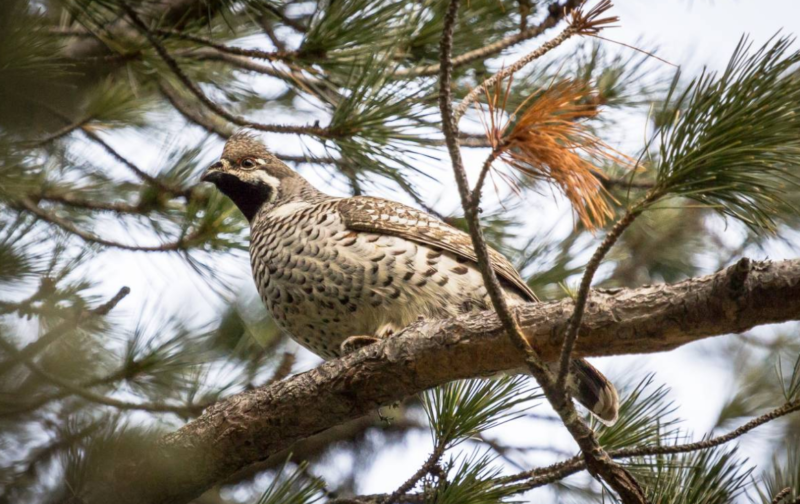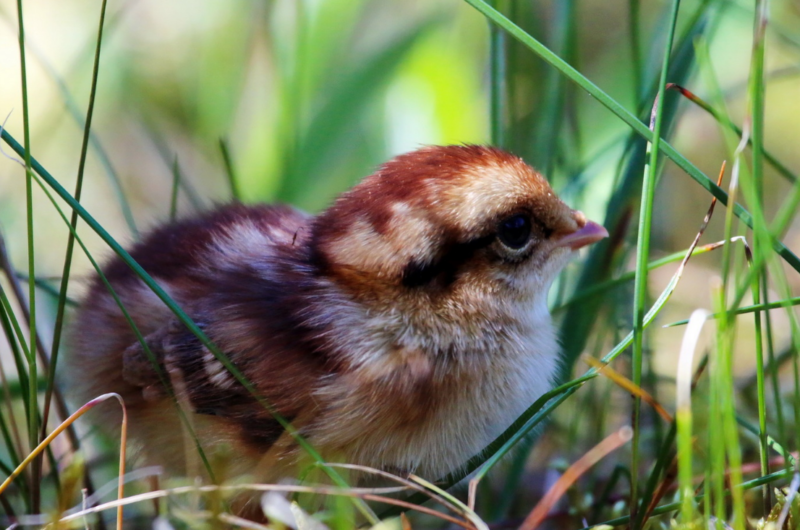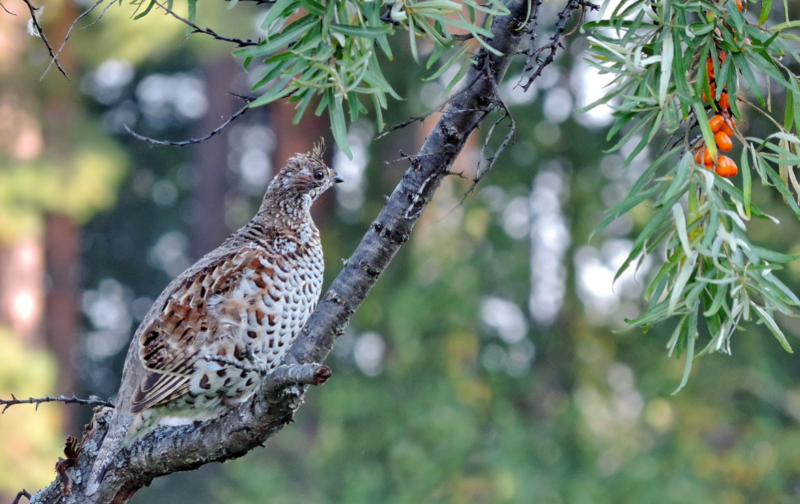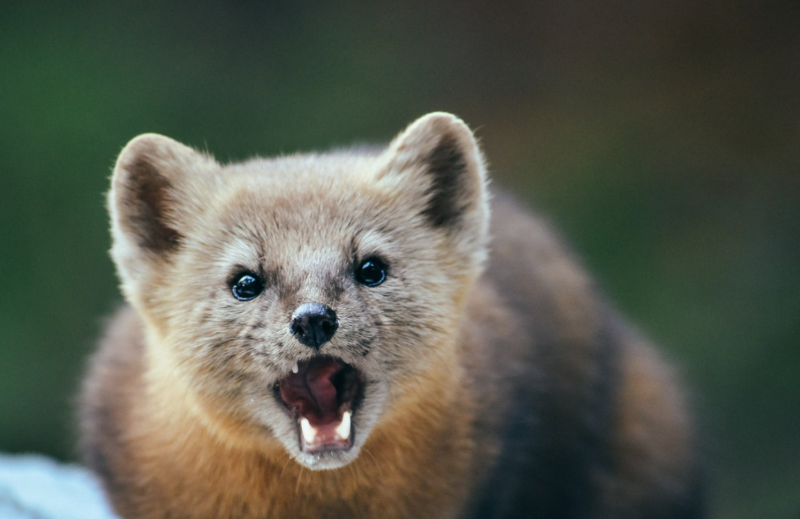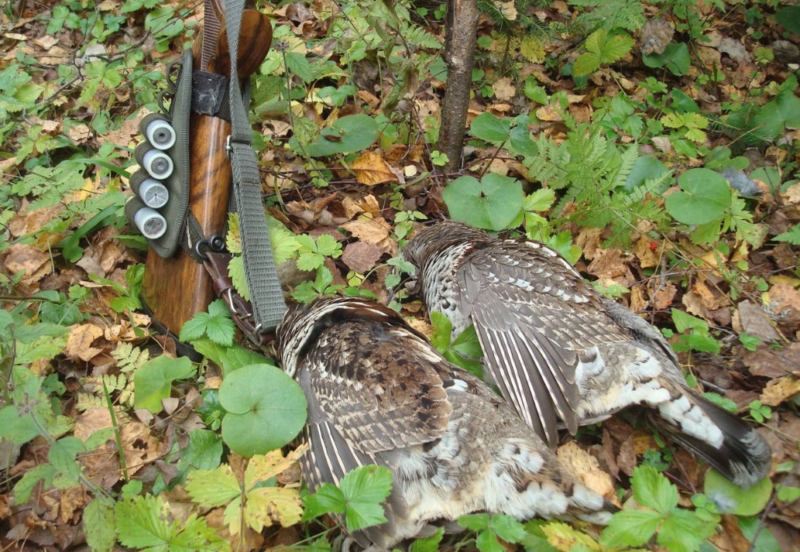This small bird living in the forests of Europe belongs to the pheasant family. The hazel grouse has a remarkable appearance, due to which it is difficult to confuse it with other feathered game. You will learn about his interesting habits from the article.
Material Content:
Description and features of common grouse
From a distance, the bird seems smoky gray, and its variegation is not so noticeable. During the flight, a strip of dark color located at the tail is visible. Grouse (Bonasa Bonasia) - small birds weighing up to 500 g with colorful plumage, in size they resemble a large pigeon or jackdaw. The greatest weight gain in the winter, and lose weight in the spring. The female almost does not differ in color from the male, but is slightly smaller than him, and the tuft on the head is barely noticeable.
Brief description of the view:
- males have a large black spot on the throat with a transition to the cervical region, bordered by a wide white stripe;
- the females also have a black spot on the neck, but the white border is almost imperceptible;
- a pattern of white semicircles is visible on a dark goiter;
- the wings are brownish-gray with light strokes below and dark spots in the middle;
- tail with transverse stripes, a black border at the bottom and a light stripe along the edge;
- over the eye is a red border;
- eyes are black, small, very sharp-sighted;
- the beak is short, strong, slightly curved;
- on the legs there are horn rims that help the bird to stay in winter on icy branches.
Little chicks are bright lumps of yellow-ginger and ocher flowers. The wingspan of an adult bird reaches half a meter, and the length of the body with a tail does not exceed 38 cm.
Character and lifestyle
The main habitat of birds is mixed forests. They stay in more often and do not approach the forest edge closer than 200-300 meters.They tolerate even severe frosts, hiding in deep snow. Common hazel grouse - moving and dexterous birds that move quickly on the ground. Spend the night in a dense bush under the large branches of fir trees. Nests are arranged on the ground, in the crown of trees (on the middle tier of branches) they are moved only in winter.
Aroused grouse raise a crest and take off with a noise, deftly maneuvering between the branches. At the same time they emit a short trill, similar to gurgling. These are rather silent birds, they communicate with each other with the help of a thin lingering whistle.
Breeding and offspring
Grouse form strong pairs, long loyal to the partner. The male selects a territory for current and nesting. As soon as the snow melts, he begins to perform the marriage ritual, showing the female his “dance”. Demonstratively takes off, fluffs the feather cover and tail, takes various enticing postures. He publishes a special song trill, and the female echoes him.
The male during the current lifts his head high, protrudes the wings and as if dragging them on the ground. The feathers on his neck at this moment rise almost vertically, and the tail opens with a fan. He runs after the female, making sharp turns and whistling. After mating, the female arranges a nest in a secluded place among the branches of a bush, the roots of tree species or in rotten large stumps. Inside the hole is covered with dry grass. Small yellowish eggs (about 10 pieces) the female incubates for 20 days. Chicks are born in late spring, they do not sit long in the nest. On the first day, the hazel grouse mom takes them to a warm light forest. On the second day of life, the kids are already trying to flutter near the ground, pecking grains and hiding under their mother's wings in case of danger.
Grouse life span
In nature, hazel grouse rarely reach the maximum age of 10 years, which nature assigned them.
Most individuals die at a young age from predatory teeth and claws, winter hunger or a hunter's gun.
This sedentary bird, which in winter remains in its habitat and does not migrate to warmer climes. When a hard crust forms in the snow, the hazel grouse cannot penetrate it and freezes from the cold. In snowless winters, the bird also has nowhere to hide from frost and predators. Chicks die from forest fires, freezing frosts or diseases. Only 50% of the brood survives to a 2-month age indicator.
Poultry diet
Grouse eat plant food and insects. Chicks are fed last. In famine, they are content with seeds of forest plants and other coarse plant foods. The diet largely depends on the habitat. In coniferous forests, hazel grouse eat young needles, they like to pick up pine nuts.
Birds sit in the snowdrifts for 19 hours, getting out only occasionally for feeding. In winter and late autumn, when the food is scarce, they eat parts of twigs, shoots, and tree buds. The main branch food for them are birch, willow, mountain ash, poplar, alder, and hazel. In summer, birds feed most of the day, looking for delicious berries, seeds and animal feed - beetles, grasshoppers, ants, larvae, caterpillars, slugs and spiders.
The birds have too good an appetite: they can absorb food immensely. When kept in a cell, this must be taken into account. Birds can even die from overeating. To improve digestion, they are given quartz chips or sand. This activates the digestion processes in the stomach, allowing the absorbed to be well absorbed.
Natural enemies
The pheasant family has many enemies among animals and birds. In the snow, hazel grouse can escape from predators threatening from the air, but animals can easily find them by smell and destroy them in large quantities. The main enemy of birds in nature is sable: during the winter, one animal eats up to 25 grouse. The carcasses of dead marten birds are harvested, and lynxes, foxes, stray dogs, and wolves enjoy it. Boars find and destroy egg clutches even in hard-to-reach places.
Economic activity of people also leads to extinction of birds: deforestation, pollution of water bodies and fields with pesticides. There are so many hazel grouses in some forests that they are lacking in food and they die of starvation.
Hazel grouse as an object of hunting
Forest bird was once an important object of hunting: it was highly valued for delicious delicious meat. Until the 70s of the last century, hundreds of thousands of grouse carcasses were exported from the Soviet state.
It is currently a popular sport hunting destination. Food lovers love white, low-fat grouse meat with a tarry aroma and light bitterness. Bird hunting in Russia and European countries is allowed only in autumn.
Previously, when large-scale commercial preparations were carried out, hazel grouses were caught using nets, traps, and loops. One hunter mined up to 200 birds per season, while only 1/3 of the prey fell into his hands, the rest was taken away by predators or spoiled.
Now common hunting with a gun with the help of a decoy that mimics the grouse's voice. This is a gambling occupation: you need to not only whistle correctly so that the bird approaches an accessible distance, but also to sit completely motionless in ambush. A hunter rarely manages to get more than 3 individuals per day. Sometimes hazel grouse is hunted with likes or surges. In captivity, keeping a bird is too time-consuming and difficult, so its industrial breeding is not practiced.
Hazel grouse is not threatened with extinction: they breed well in nature, their livestock in recent decades has been steadily increasing. Most of the multi-million population of birds lives in Russia, being its property and pride.


